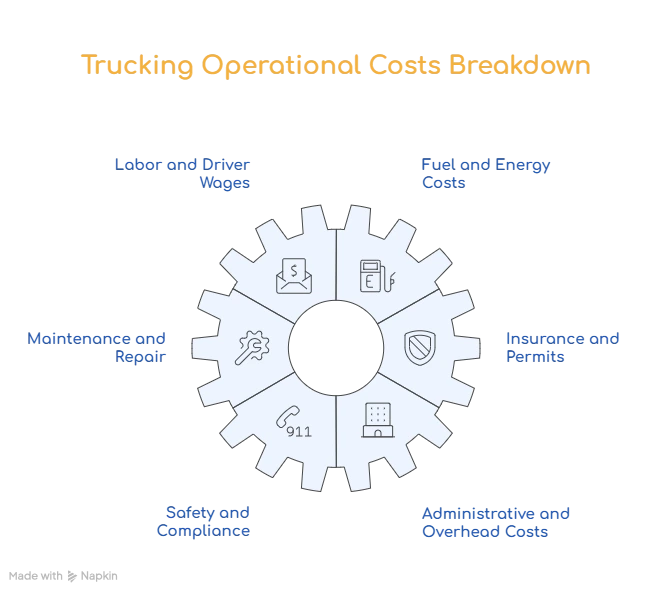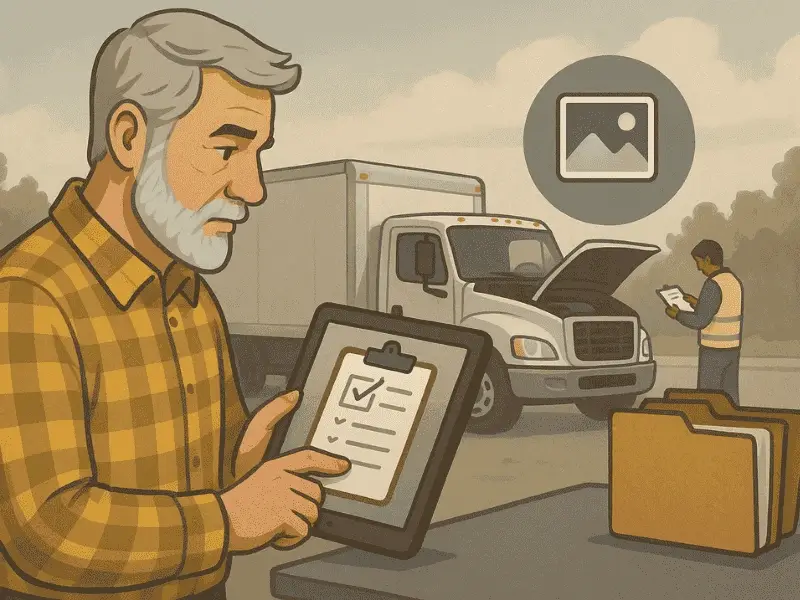Key Takeaways
- Labor and fuel are the biggest cost drivers (up to 70% combined).
- Preventive maintenance saves thousands in repair downtime.
- Safety tech and compliance reduce accident-related losses.
- Data-driven route optimization cuts fuel and load inefficiency.
- A smart fleet management system helps reduce trucking expenses and increase profitability.
Starting a trucking business can be an exciting venture but it’s also one that requires careful financial planning and strategic decision-making. Whether you’re an owner-operator starting with one truck or a fleet manager scaling up your operations, understanding the operational costs of trucking is essential to staying profitable and competitive.
Trucking drives the global economy. But behind every successful shipment lies a complex cost structure from fuel trucking expenses and maintenance to insurance, safety, and compliance. In this article, we’ll break down the trucking company cost structure, explore key expenses, and share practical strategies to reduce freight operational costs and maximize profits.
What Are the Main Operational Costs of Trucking?

Running a trucking business involves numerous expenses that collectively define your cost per mile and profitability. The trucking operational costs typically include:
- Labor and driver wages
- Fuel and energy costs
- Maintenance and repair
- Insurance and permits
- Safety and compliance
- Administrative and overhead costs
Each of these categories affects your bottom line differently. Let’s look at how each factor contributes to the trucking cost breakdown and how to manage them efficiently.
Labor Costs: Your Biggest Investment
Labor remains the largest single expense for most fleets, making up roughly 30% of total trucking expenses. Skilled drivers are in high demand, and retaining them requires competitive pay, benefits, and working conditions.
What’s included:
- Base salary and hourly pay
- Overtime and bonuses (performance or safety-based)
- Health insurance, retirement plans, and paid leave
- Recruiting, onboarding, and training costs
How to manage labor expenses:
- Introduce driver performance monitoring systems to reward safe, fuel-efficient driving.
- Offer training programs that reduce turnover and improve safety records.
- Use fleet management software to track hours, optimize routes, and reduce overtime.
Fuel: The Most Unpredictable Cost
Fuel is often the most volatile component of trucking operational costs, accounting for 30–40% of total expenses. With fluctuating diesel prices and varying haul distances, the fuel trucking cost can make or break profitability.
Key factors affecting fuel cost:
- Fuel price fluctuations
- Vehicle type and load weight
- Idling time and driving habits
- Route efficiency and congestion
Tips to control fuel spend:
- Invest in fuel-efficient or alternative fuel vehicles (CNG, LNG, or hybrid models).
- Use route optimization tools to avoid congestion and minimize idling.
- Train drivers in eco-driving practices
- Monitor fuel consumption per mile using telematics and analytics tools.
- Implement fuel surcharge programs to balance costs with customer pricing.
Maintenance and Repairs: Keeping Trucks on the Road
Maintenance and repair costs typically represent 10–15% of trucking transportation costs. Every mile adds wear and tear and neglecting upkeep can quickly turn small issues into major expenses.
Main maintenance expenses:
- Regular servicing (oil changes, filters, brake checks)
- Tire replacement and rotation
- Engine and transmission repairs
- Unexpected breakdowns and towing costs
How to reduce repair costs:
- Follow a preventive maintenance schedule to catch issues early.
- Adopt predictive maintenance systems that use real-time data to forecast component failures.
- Track maintenance histories through a fleet management platform to plan servicing proactively.
- Keep spare parts and tires in stock to minimize downtime.
Predictive and preventive maintenance strategies can reduce downtime, lower repair bills, and extend vehicle life, all while keeping drivers safe on the road.
Insurance: Protecting Your Assets
Insurance is an essential part of running a trucking company, covering everything from cargo to liability. It generally accounts for 4–10% of overall operational costs of trucking, depending on the fleet size, cargo type, and claim history.
Types of insurance coverage:
- Auto liability
- Cargo insurance
- Physical damage coverage
- Workers’ compensation
- General liability
Factors influencing premiums:
- Accident history and safety record
- Type of cargo (hazardous materials, high-value goods)
- Driver experience and training
- Geographical routes
Ways to control insurance costs:
- Improve your safety record through technology (AI dashcams, collision alerts).
- Conduct regular driver training to reduce accidents.
- Maintain strong compliance with FMCSA standards.
- Review insurance policies annually to avoid overpaying for outdated coverage.
Safety and Compliance: The Hidden but Crucial Expense
Safety-related expenses often go unnoticed in traditional trucking cost breakdowns, yet they play a major role in protecting both your people and your profits.
Safety costs include:
- Safety technology (AI dashcams, automatic braking, lane assist)
- Compliance with FMCSA regulations
- Drug and alcohol testing
- Audits and inspections
- Driver safety training
Why safety matters financially:
A single accident can cost millions. According to the FMCSA, a fatal truck crash averages over $3.6 million in losses, including legal costs, medical claims, and vehicle damage.
Safety investments that pay off:
- Use telematics to monitor unsafe driving and correct behavior early.
- Automate compliance tracking to ensure HOS (Hours of Service) accuracy.
- Conduct periodic safety audits to identify risks before they escalate.
Administrative and Overhead Costs
In addition to direct trucking expenses, fleets incur administrative and overhead costs, typically around 5–10% of total operations.
Common overhead costs:
- Office rent, utilities, and supplies
- Accounting and legal services
- Software subscriptions (dispatch, payroll, telematics)
- Licensing and permits
- Marketing and client management
Digital transformation is helping fleets streamline administrative workflows. By using automation and cloud-based systems, you can reduce paperwork, minimize human error, and improve visibility across your business.
How to Reduce Freight Operational Costs and Improve Profitability
Running a trucking business efficiently requires more than cutting costs. It’s about optimizing every process. Here are practical ways to improve profitability while keeping your fleet in top shape.
Download a Free Truck Maintenance Checklist
The Long-Term Payoff: Safety, Sustainability, and Savings
A profitable trucking business balances cost efficiency with safety and compliance. Companies that integrate safety technology, data analytics, and sustainability practices not only save money but also gain a competitive edge in the logistics industry.
By understanding and actively managing your trucking transportation costs, you position your fleet for long-term stability, even when fuel prices fluctuate or freight markets slow down.
Simplify Fleet Operations and Cut Costs with Simply Fleet
The operational costs of trucking go far beyond fuel and wages, they reflect the daily choices you make in safety, maintenance, and efficiency. Running a trucking company means managing hundreds of moving parts.
With Simply Fleet’s all-in-one fleet management software, you can simplify operations, reduce costs, and keep your trucks road-ready. From fuel tracking to maintenance alerts, Simply Fleet helps you make every mile count. Start optimizing your trucking operations with Simply Fleet today.



.png)








.png)


.png)






.png)



